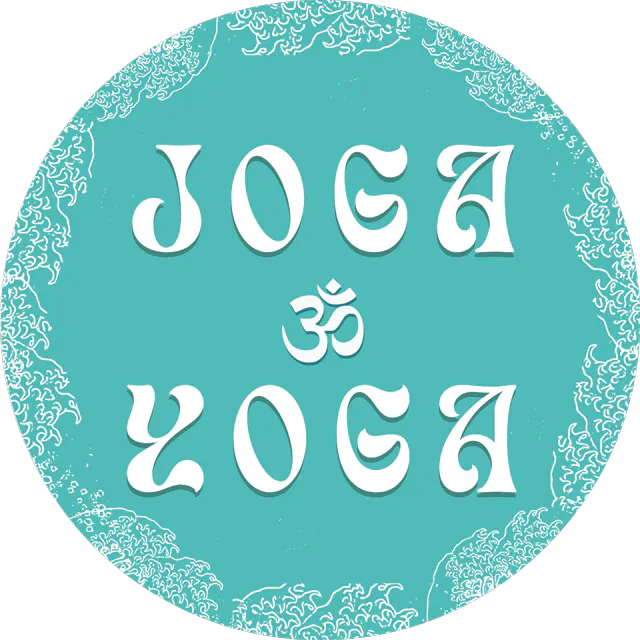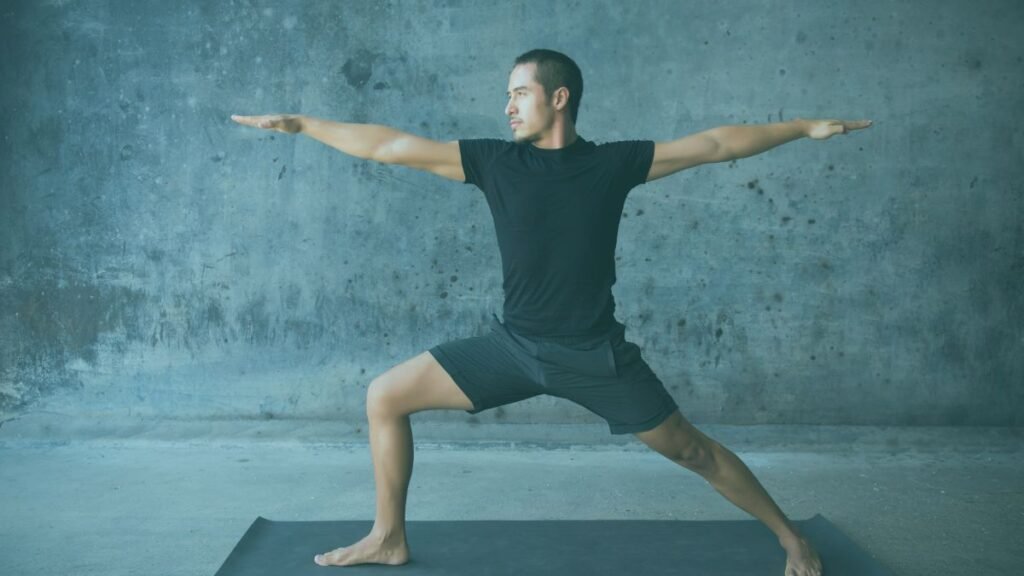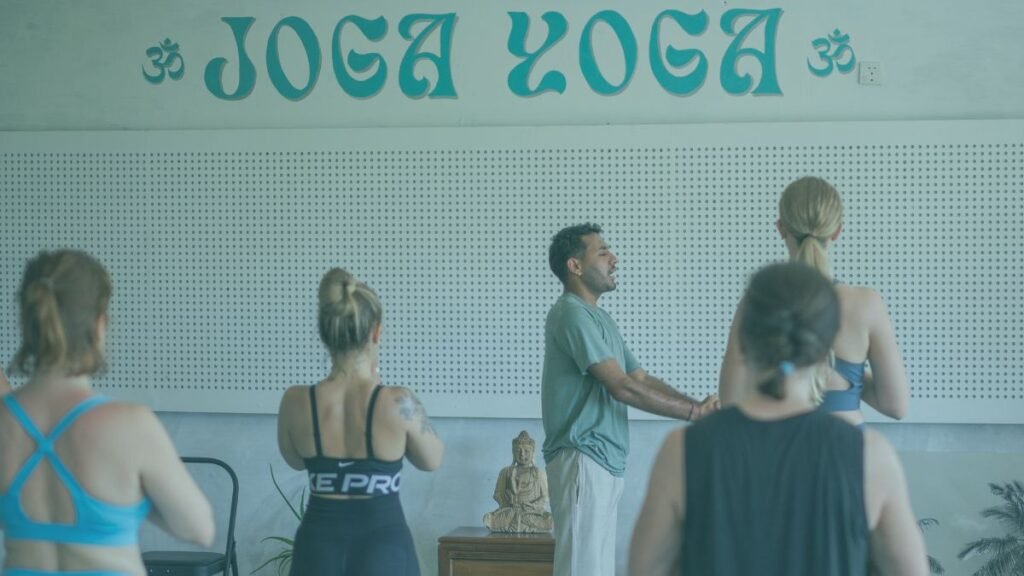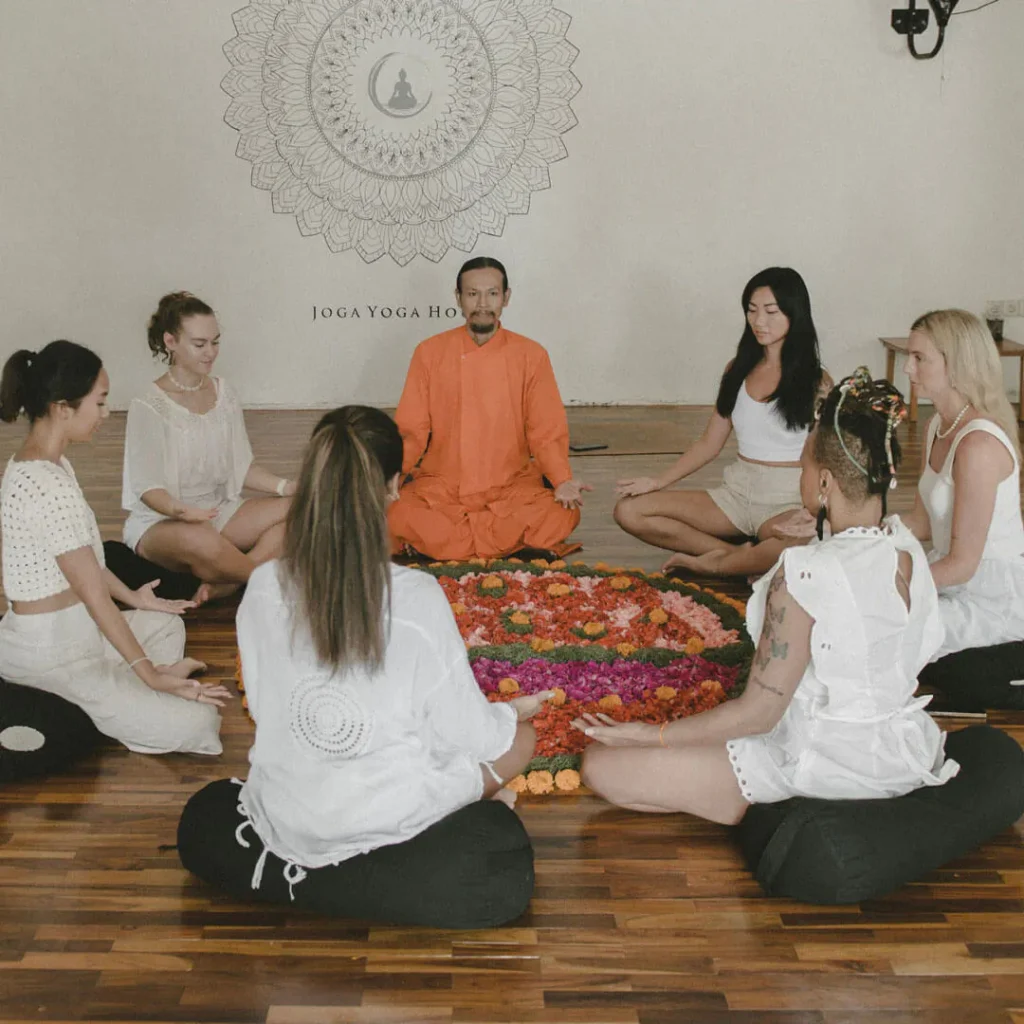Discover how much yoga teacher training in Bali costs, the best certified schools, daily schedules, visa tips, and certification levels. Compare Ubud vs Canggu programs and start your YTT journey.
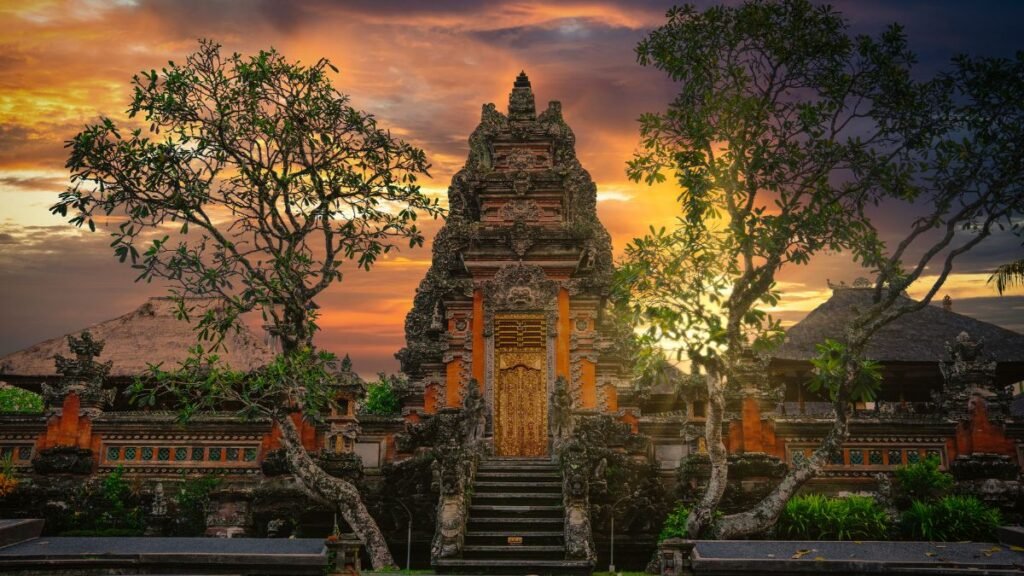
Why Choose Bali for Yoga Teacher Training?
What makes Bali the global hub for YTT?
Bali is one of the most popular destinations in the world for yoga teacher training because it blends spiritual tradition, natural beauty, and affordability. Called the “Island of the Gods,” Bali is filled with temples, rituals, and ceremonies that make it the perfect backdrop for yoga. Unlike many places where yoga is just fitness, in Bali it becomes a full lifestyle of meditation, philosophy, and connection.
Thousands of students choose Bali every year because most schools are Yoga Alliance certified, meaning you can teach yoga anywhere in the world after graduation.
Ubud vs. Canggu vs. Other Areas in Bali
When choosing your yoga teacher training in Bali, the location plays a big role in your overall experience. Each area has its own unique vibe, community, and energy that can shape your journey.
| Location | Vibe | Best For |
| Ubud | Jungle, spiritual, artsy | Deep spiritual immersion, silence, nature |
| Canggu | Coastal, hip, surf culture | Community, modern yoga lifestyle, sunsets |
| Uluwatu | Cliffs, calm, ocean views | Luxury retreats, advanced practice |
| Lovina | Remote, quiet | Off-the-grid detox and full immersion |
- Ubud is Bali’s spiritual heart, surrounded by temples, rice paddies, and misty jungles. It’s the ideal choice if you’re seeking silence, healing, and a deeper connection to yoga philosophy. Think sound healing, cacao ceremonies, and eco-resorts.
- Canggu is the island’s modern yoga village. Expect surf breaks, smoothie bowls, coworking cafes, and a thriving expat community. If you want a balance of yoga, lifestyle, and social connection, Canggu is the perfect hub.
- Uluwatu offers dramatic cliffside views and serene beaches. It’s home to luxury retreats and attracts yogis looking for calm and more advanced or private training experiences.
- Lovina is the opposite vibe—remote, peaceful, and perfect for those seeking complete detox and immersion away from crowds.
👉 For most students, Ubud and Canggu are the top choices. Ubud offers inward focus, while Canggu provides community energy. Both support transformation, but the choice depends on whether you want to go deeper into meditation and philosophy or enjoy a balanced lifestyle with yoga, surf, and social life.
✨ If you’re drawn to Canggu’s vibrant yoga scene and modern lifestyle, Joga Yoga’s Yoga Alliance–certified YTT is located just minutes from Batu Bolong Beach. With small class sizes, nourishing plant-based meals, and a supportive community, it’s one of the most popular choices for students who want a balance of training and lifestyle in Bali.

Why Bali attracts aspiring yoga teachers worldwide
- Affordable compared to the West: Training in Bali costs less than similar programs in the U.S. or Europe, while still offering top-quality teachers and facilities.
- International community: You’ll meet students and teachers from all over the world. Many leave with lifelong friendships and even career opportunities.
- Balance of tradition and modern wellness: Bali blends ancient yoga roots with modern approaches like anatomy, Ayurveda, sound healing, and meditation.
How Much Does Yoga Teacher Training in Bali Cost?
Typical range: budget, mid-tier, luxury programs
The cost of yoga teacher training in Bali usually ranges from €1,000 to €4,000, depending on the length of the course and the type of accommodation:
- Budget programs: €1,000 – €1,500 (shared dorms, basic meals, short courses like 100h YTT)
- Mid-range programs: €1,500 – €3,000 (twin share or private rooms, daily meals, excursions, 200h YTT)
- Luxury programs: €3,000 – €5,000+ (private villas, spa treatments, full retreat-style training, often 300h or 500h YTT)
What’s included in the fees (meals, housing, excursions)
Most Bali yoga schools include:
- Accommodation (10 to 30 nights depending on course length)
- Daily plant-based meals (vegetarian or vegan)
- All books, manuals, and study materials
- Yoga Alliance certification (100h, 200h, or 300h depending on the program)
- Excursions to temples, rice terraces, or waterfalls
- Balinese massage, sound healing, or kirtan sessions
- Airport pick-up and community activities
👉 At Joga Yoga in Canggu, inclusions go further:
- 200-Hour YTT: from €1,550 (non-accommodation) to €2,999 (deluxe private room) with 22 nights stay, daily plant-based meals, traditional Balinese massage, temple excursions, surf lessons, and sauna/cold plunge recovery.
- 100-Hour YTT: from €1,049 to €1,699 for 11 nights. Perfect for beginners or those who want a shorter, foundation course.
- 300-Hour YTT: from €2,099 to €3,650 for 29 nights. Includes advanced training, holistic detox practices, and specialized modules in anatomy, philosophy, and teaching methodology.
Comparison table: 100h, 200h, 300h, 500h YTT
| Program | Duration | Best For | Average Cost in Bali | Joga Yoga Pricing |
| 100-Hour YTT | ~10–12 days | Beginners, personal growth | €900 – €1,500 | €1,049 – €1,699 |
| 200-Hour YTT | ~21–24 days | First-time teachers, Yoga Alliance certification | €1,500 – €3,000 | €1,550 – €2,999 |
| 300-Hour YTT | ~28–30 days | Advanced training, RYT-500 path | €2,500 – €4,000 | €2,099 – €3,650 |
| 500-Hour YTT | Combined 200h + 300h | Professional teachers, retreat leaders | €4,000 – €6,000+ |
What Is the Best Yoga Teacher Training in Bali?
Criteria: accreditation, class size, teaching team
The best yoga teacher training in Bali is usually defined by three main criteria:
- Accreditation: Always choose a Yoga Alliance–certified school. This ensures your certificate is internationally recognized.
- Class size: Smaller groups (20–25 students) allow for more personal guidance, hands-on adjustments, and stronger community bonds.
- Teaching team: Look for schools with diverse instructors — philosophy teachers, anatomy specialists, and experienced yoga practitioners.
Popular schools and their specialties
Bali has hundreds of yoga schools, but some focus on specific niches:
- Multi-Style YTT (Hatha, Vinyasa, Yin): Most common in Bali, perfect for beginners and aspiring teachers.
- Ashtanga-Focused: Best if you prefer disciplined, structured practice.
- Kundalini YTT: For those who want to explore kriyas, chanting, and spiritual awakening.
- Restorative/Yin YTT: Ideal if you are more interested in healing and therapeutic yoga.
Why Joga Yoga is trusted for Yoga Alliance-certified YTT
At Joga Yoga in Canggu, students train in multi-style yoga — Hatha, Vinyasa, Ashtanga, Yin, and Restorative — guided by a team of international teachers, Balinese monks, and anatomy specialists.
- Yoga Alliance certified: Graduates earn globally recognized RYT-200 or RYT-300 credentials.
- Small class sizes: Max 25 students for personalized mentorship.
- Holistic inclusions: Daily yoga practice, pranayama, meditation, anatomy, philosophy, Balinese massage, and excursions to sacred water temples.
- Trusted reputation: Over 2,000 graduates with 4.8+ reviews on Google and Yoga Alliance.
👉 This makes Joga Yoga one of the most recommended options for students looking for a balance of affordability, quality, and authentic Balinese immersion.
How Long Is Yoga Teacher Training in Bali?
100-hour (11 days), 200-hour (22 days), 300-hour (29 days)
- 100-Hour YTT: ~11 days. Perfect for beginners who want a foundation without committing to the full certification.
- 200-Hour YTT: ~22 days. The most popular program, required for Yoga Alliance’s RYT-200 certification.
- 300-Hour YTT: ~29 days. Designed for teachers who already completed a 200h course and want advanced training.
Should you do 200 + 300 separately or one 500-hour course?
Most students take the 200h and 300h separately. This gives time to absorb, teach, and gain experience before deepening knowledge. A 500h integrated course is also possible but less common, and requires a full two-month commitment.
👉 At Joga Yoga, many graduates complete the 200h first and return later for the 300h, eventually registering as RYT-500 with Yoga Alliance.
Sample daily schedule in Bali YTT
A typical day in a Bali YTT blends yoga practice, study, and reflection. Here’s a sample from Joga Yoga’s 200-Hour program:
- 06:30 – 07:00: Pranayama & Kriya
- 07:00 – 08:30: Hatha & Vinyasa practice
- 08:30 – 10:00: Breakfast
- 10:00 – 12:30: Philosophy, Anatomy, or Ayurveda lectures
- 12:30 – 14:30: Lunch & rest
- 14:30 – 16:30: Teaching methodology & alignment
- 16:30 – 17:30: Yin yoga & evening meditation
This balance of practice, study, and self-reflection is what makes YTT in Bali transformational both on and off the mat.
What Certificate Do You Get After YTT in Bali?
RYT 200, RYT 300, RYT 500 explained
- RYT-200: For students who complete a 200h program. This is the minimum requirement to start teaching yoga worldwide.
- RYT-300: For students who already have RYT-200 and complete an advanced 300h program.
- RYT-500: For students who complete both 200h + 300h (either separately or together). This is the highest standard for professional teachers.

Yoga Alliance recognition worldwide
Yoga Alliance is the global standard for yoga teacher training. Once registered, you can legally and professionally teach in gyms, studios, retreats, and private classes worldwide.
How Joga Yoga certification helps you teach globally
Graduates of Joga Yoga’s Yoga Alliance–certified programs receive official RYT-200, RYT-300, or RYT-500 credentials. This means you can:
- Teach in any country across the world
- Open your own yoga studio or wellness retreat
- Lead workshops, retreats, or online classes
- Join a global network of yoga teachers
👉 With over 2,000 graduates since 2017, Joga Yoga has built a strong international reputation that helps its students launch careers in yoga worldwide.
How Much Do Yoga Teachers Make in Bali?
Average earnings for yoga instructors in Bali
Yoga teachers in Bali usually earn between IDR 100,000 – 300,000 ($7–$20 USD) per class when teaching at studios. Monthly income depends on workload, but many teachers make around $800–$1,500 per month.
However, Bali isn’t just about fixed salaries. The real income comes from flexibility and creativity.
Other ways teachers earn (retreats, workshops, privates)
Aside from teaching at studios, yoga instructors in Bali often increase their earnings through:
- Private sessions: $25–$60 USD per class depending on experience.
- Workshops: Specialized topics like arm balances, meditation, or Ayurveda can bring in higher fees.
- Retreats: Hosting or co-hosting yoga retreats is one of the most profitable options.
- Online teaching: Many teachers supplement their Bali income with Zoom classes, online courses, or Patreon memberships.
👉 Many Joga Yoga graduates stay in Bali to teach at local studios, while others launch retreat businesses or online yoga platforms after certification.
Which countries pay yoga teachers the most?
If your long-term goal is financial stability, you may want to teach internationally. According to global yoga income reports:
- USA, Canada, and Australia: Highest-paying markets, with rates of $40–$80 per class.
- Europe (Germany, UK, Netherlands): €30–€60 per class.
- Asia (Japan, Singapore, Hong Kong): Growing demand, competitive pay.
👉 A Bali YTT certificate (RYT 200/300/500) from Yoga Alliance allows you to teach anywhere in the world.
Is Bali Safe for Solo Travelers (Especially Women)?
Safety in Ubud, Canggu, and other areas
Yes, Bali is considered very safe for solo travelers, including women. Popular yoga hubs like Ubud and Canggu have strong expat communities, safe accommodations, and plenty of wellness-focused spaces.
Petty theft (like scooter or bag snatching) can happen, but violent crime is rare. Most visitors feel more comfortable in Bali compared to many other tourist destinations in Asia.
Community vibes and expat networks
One of Bali’s strengths is its welcoming expat and wellness community. Many students arrive alone for yoga teacher training and quickly form lifelong friendships with classmates. In areas like Ubud, Canggu, and Uluwatu, you’ll find coworking cafes, women’s circles, cacao ceremonies, and healing workshops that make it easy to connect.
Tips for first-time solo travelers
- Book trusted accommodations or yoga schools that include airport pick-up (like Joga Yoga).
- Use scooter rentals or GoJek/Grab apps for safe transport.
- Stay in central areas (Ubud town, Batu Bolong in Canggu) rather than remote locations at first.
- Respect local customs, especially when visiting temples.
👉 Many Joga Yoga students are solo female travelers who find the training supportive, safe, and community-driven.
What Do You Learn in Yoga Teacher Training in Bali?
Beyond the poses: philosophy, anatomy, pranayama
Yoga teacher training is much more than practicing asanas. A complete YTT curriculum in Bali typically includes:
- Yoga philosophy: The Yoga Sutras, Bhagavad Gita, and the 8 Limbs of Yoga.
- Anatomy & physiology: Functional movement, injury prevention, biomechanics.
- Pranayama & meditation: Breathwork, kriyas, chanting, mindfulness.
- Lifestyle & ethics: How to live yoga off the mat.
Styles of yoga taught (Hatha, Vinyasa, Yin, Ashtanga, Kundalini)
Most Bali schools offer multi-style programs, exposing you to several traditions. At Joga Yoga, you’ll train in:
- Hatha & Vinyasa (core focus, creative sequencing)
- Ashtanga (structured discipline)
- Yin & Restorative (healing practices)
- Meditation & Yoga Nidra (mental clarity, relaxation)
- Optional Kundalini elements (breath, mantra, energy awakening)
Hands-on teaching practice and practicum
A major part of YTT is learning how to teach. You’ll:
- Practice sequencing and cueing classes.
- Learn hands-on adjustments and alignment.
- Lead small group classes with feedback from senior teachers.
👉 By the end of a 200h YTT at Joga Yoga, you’ll feel confident to teach Hatha, Vinyasa, and Yin yoga anywhere in the world.
What Is Daily Life Like During YTT in Bali?
Example daily schedule (morning to evening)
A yoga teacher training in Bali is a full immersion — not a retreat, but a lifestyle shift. A typical day looks like this:
Sample Daily Schedule at Joga Yoga (200h YTT):
- 06:30 – 07:00 → Pranayama & Kriya
- 07:00 – 08:30 → Hatha or Vinyasa practice
- 08:30 – 10:00 → Vegan/vegetarian breakfast
- 10:00 – 10:30 → Meditation & chanting
- 10:30 – 12:30 → Yoga philosophy or anatomy
- 12:30 – 14:30 → Lunch & free time
- 14:30 – 16:30 → Teaching methodology & alignment
- 16:30 – 17:30 → Yin or restorative practice
- Evening → Journaling, satsang, or community events
👉 Expect long but deeply rewarding days that balance practice, study, and self-reflection.
Meals, community, and weekend excursions
At most schools, including Joga Yoga, meals are plant-based, organic, and nourishing — smoothie bowls, curries, fresh fruits, herbal teas. Food is designed to support energy and digestion.
The community is one of the best parts. You’ll train with students from all over the world, forming friendships that last well beyond the course.
On weekends, schools often organize excursions such as:
- Waterfall hikes
- Visits to sacred temples
- Beach days and surf lessons
- Sound healing or cacao ceremonies

Accommodation options (dorms, twin-share, private rooms)
Your Bali YTT experience can be as budget-friendly or luxurious as you want:
- Dorm rooms: Affordable, shared with 4–6 students.
- Twin-share rooms: Comfortable, ideal for connection with one roommate.
- Private rooms: King-size beds, ensuite bathrooms, modern comfort.
👉 At Joga Yoga, you can choose from non-accommodation, dorm, twin, private, or deluxe private rooms, all located near Canggu’s beaches.
What Visa Do You Need for Yoga Teacher Training in Bali?
Visa on Arrival (VOA) vs. Social-Cultural Visa (B211)
For most YTT students, there are two main options:
- Visa on Arrival (VOA)
- Valid: 30 days, extendable to 60 days
- Cost: ~$35 USD + extension fee
- Easiest option for 100h or 200h programs
- Valid: 30 days, extendable to 60 days
- Social-Cultural Visa (B211)
- Valid: 60 days initially, extendable up to 180 days
- Best for students staying longer or combining multiple trainings
- Must be arranged in advance, usually via an agent
- Valid: 60 days initially, extendable up to 180 days
Costs, extensions, and agents in Bali
- VOA: $35 at the airport + ~$50 for extension
- B211: $100–$150 for initial setup + ~$50 monthly extension
- Many schools (including Joga Yoga) recommend trusted visa agents who handle the process, saving you time at immigration offices.
Travel tips for a smooth entry
- Passport must be valid for at least 6 months
- Bring a return or onward flight ticket (immigration may ask)
- Keep the address of your yoga school ready
- Plan your visa according to your training length (don’t risk overstaying)
When Is the Best Time of Year to Do YTT in Bali?
Dry season vs. wet season
- Dry Season (April–October) → Best weather, clear skies, less humidity. Perfect for outdoor yoga and weekend excursions.
- Wet Season (November–March) → More rain and humidity, but quieter, cheaper, and more reflective — great for inner work.
Peak months and quieter times
- May, June, September → Best balance of good weather and fewer crowds.
- July & August → Peak tourist season, higher prices, busier beaches.
- January & February → Low season, peaceful atmosphere, best for students who want small group sizes.
Cultural considerations (Nyepi, Ramadan)
- Nyepi (Day of Silence) → Usually in March. The entire island shuts down for 24 hours, no travel, no electricity. A unique but restrictive day if it falls during your training.
- Ramadan → Affects flights and services in Indonesia (though Bali is mostly Hindu).
👉 The best time depends on your goals:
- Want social energy and sunshine? → Dry season.
- Want inner focus and calm? → Wet season.
What to Pack for Yoga Teacher Training in Bali?
Clothing for tropical climate
Bali is hot and humid year-round, so you’ll want lightweight, breathable clothing.
- Yoga wear: 4–6 tops, 3–5 leggings or shorts
- Casual wear: loose dresses, t-shirts, sarongs
- Layer: one light sweater for Ubud evenings or early mornings
- Footwear: sandals or slip-ons for daily use, sneakers for excursions
👉 Pro tip: Laundry is cheap and easy in Bali, so pack light.
Yoga gear essentials
Most schools provide mats and props, but many students prefer bringing their own.
- Travel yoga mat or mat towel
- Yoga strap & 2 blocks (optional)
- Reusable water bottle (filtered recommended)
- Small backpack for daily use
Toiletries, study materials, and travel docs
- Toiletries: reef-safe sunscreen, mosquito repellent, natural shampoo, coconut oil
- Wellness items: essential oils, magnesium spray, electrolytes
- Study materials: journal, pens, highlighters
- Travel docs: passport (6+ months valid), visa, travel insurance, return flight proof
✅ Keep your packing minimal and intentional — your focus should be on learning and self-growth, not overstuffing your suitcase.
Final Thoughts: Is Bali the Right Place for Your Yoga Teacher Training?
Bali has become one of the world’s most popular yoga teacher training destinations, and for good reason:
- Spiritual energy and cultural richness
- Affordable, high-quality programs
- Supportive international yoga community
Who it’s ideal for:
- Beginners → looking to build a foundation in yoga & meditation
- Intermediate yogis → ready to take the next step with RYT-200
- Advanced practitioners → seeking specialization with 300h or 500h
Why Joga Yoga Stands Out in Bali
✅ Yoga Alliance certified → teach globally
✅ Small class sizes → max 25 students for personal attention
✅ Community-focused → supportive, family-like environment
✅ Prime location → based in Canggu, Bali’s modern yoga hub near the beach
Joga Yoga Teacher Training in Bali: Program Comparison
| Program | Duration | Best For | What You’ll Learn | Certification | Price Range (Discounted) | Accommodation Options |
| 100-Hour YTT | 11 days | Beginners, self-growth | Asana fundamentals, pranayama, philosophy, anatomy basics | Certificate of Completion | €1,049–€1,699 | Non-accommodation, dorm, twin, private |
| 200-Hour YTT | 22 days | First-time teachers, Yoga Alliance recognition | Hatha, Vinyasa, Yin, meditation, teaching methodology, anatomy | Yoga Alliance RYT-200 | €1,550–€2,999 | Non-accommodation, dorm, twin, standard, deluxe private |
| 300-Hour YTT | 29 days | Experienced teachers, specialization | Advanced asana, pranayama, philosophy, Ayurveda, trauma-sensitive yoga | Yoga Alliance RYT-300 (progression to RYT-500) | €2,099–€3,650 | Non-accommodation, twin, standard, deluxe private |
Which Program Should You Choose?
- 100h YTT → Perfect intro for beginners who want growth without committing to a full teacher certification.
- 200h YTT → The most popular option, ideal if you want to start teaching yoga globally.
- 300h YTT → Advanced training for yogis who already hold a 200h certification.
Start Your Journey with Joga Yoga in Bali
Joga Yoga offers multi-style yoga teacher training at every level:
- 100h YTT (11 days) → A strong foundation for beginners
- 200h YTT (22 days) → The industry-standard certification
- 300h YTT (29 days) → Advanced practice & teaching skills
- 500h YTT → Combined path to mastery
Your journey begins in Bali with world-class teachers, soulful practices, and a global community.
👉 Apply Now For Upcoming Training Dates
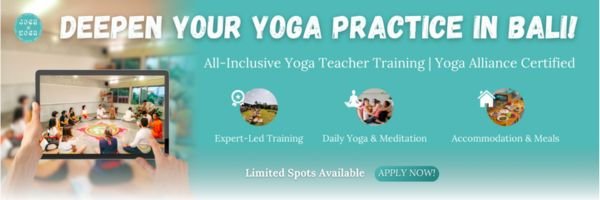
FAQs About Yoga Teacher Training in Bali
How much does a yoga class cost in Bali?
A single drop-in class costs IDR 120,000–150,000 ($8–10 USD). YTT programs include daily classes as part of the tuition.
What is the best yoga qualification?
The most recognized certification is the Yoga Alliance RYT-200. From there, you can progress to RYT-300 and RYT-500 for advanced credentials.
How old are most yoga instructors?
Most yoga teachers worldwide are between 25–45 years old, but in Bali you’ll find both young travelers and experienced yogis in their 50s+ pursuing YTT.
Is it hard to become a certified yoga instructor?
YTT is intensive but achievable. The biggest challenge is consistency and self-discipline. Schools like Joga Yoga provide step-by-step guidance and small class sizes to support every student.
Can I do yoga teacher training if I’m a beginner?
Yes. Many students start YTT to deepen their own practice, not necessarily to teach. Joga Yoga’s 100h and 200h programs are beginner-friendly while still meeting international standards.
Still unsure? This post may help: 10 Signs You’re Ready for YTT and Why Bali is the Best Place to Start
What certificate will I receive after completing the course?
All graduates of Joga Yoga’s 200-hour and 300-hour teacher training programs receive an internationally recognized Yoga Alliance certification. This qualifies you to teach anywhere in the world and register as an RYT-200 or RYT-500 depending on your program.
What’s the average class size?
To maintain quality and personal attention, Joga Yoga limits most trainings to a maximum of 25 students. This ensures everyone gets individualized feedback, hands-on support, and the chance to build real community with peers and teachers.
Can I continue my training after completing the 200-hour course?
Yes. Many students return to complete their 300-hour training to earn the full 500-hour certification. This is ideal for those who want to specialize, lead retreats, or take their teaching career to the next level.
Learn more about the 300-hour program here.
